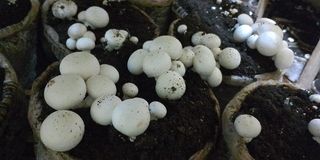How to set up a mushroom farm the easy way

Mushrooms growing in a room inside Harrison's farm in Ngata on May 21, 2024.
Agriculture has long been associated with poverty and often, what readily comes to mind when many think of farming is overworked farmers with crude tools on a rural farm.
It also has always been thought of as an option to make money that one can decide to monitor through their mobile phone (telephone farming).
However, young farmers are devising low-tech urban food production mechanisms to promote food security and resilience in urban areas.
One such crop that can be grown with ease is mushroom farming. However, with dedication and expertise, cultivating a delicate crop can yield rewarding harvests.
To start, one needs to set up a dark, well-ventilated grow house with regulated temperature and humidity levels -with ideal temperatures of 5–30 degrees Celsius, a humidity level of 80–90%, substrate (grow medium), and water.
Next, prepare the substrate by taking the wheat straw and soaking it in water for 6-7 days until properly soaked.
It is then mixed with chicken manure, urea, and wheat bran and composted for three days, after which you turn and mix it to ensure every part of the substrate has gotten enough nutrients and minerals.
After three or four days, you mix again adding other minerals like cotton seed cake. Qualities of a good substrate include a good smell, measuring pH, and ensuring temps of below 23 degrees.
Spawning.
Here, mushroom seeds (spawns) are introduced by scattering them around the substrate and ensuring even mixing. Then pack it in polythene bags and close them off to ensure high CO2 content. For 14 days they’re kept in the incubation room with low temps of 23.
After 14 days, a casing soil, usually virgin soil obtained from forests in un-farmed land, is steamed, and agricultural lime and coco peat are added to help improve the structure of the soil. This is later introduced to the growing bags in 1 or 1.5 inches then the bags are closed off.
After another 14 days, the temperatures are again reduced by thatching them until ready for the fruiting stage.
After five to six days, the pins begin to form and harvesting can begin. This occurs every eight hours in the morning and evening and can go on for about 6-8 weeks.
Afterward, discard the substrate in your farm as it is a good source of manure or biogas or as feed for black soldier flies usually consumed by poultry.
Throughout the process, look out for pests such as snails and fruit flies as well as diseases.
But most importantly, before setting up the business, ensure you have a clear business plan and a ready market to offset your produce upon maturity.

